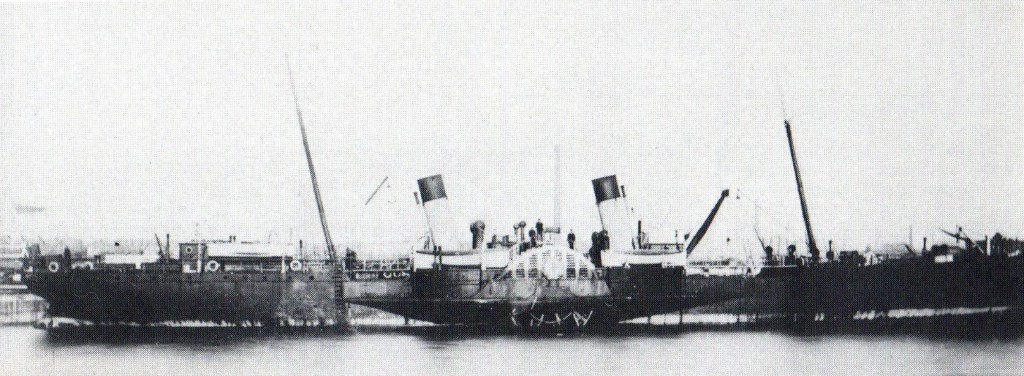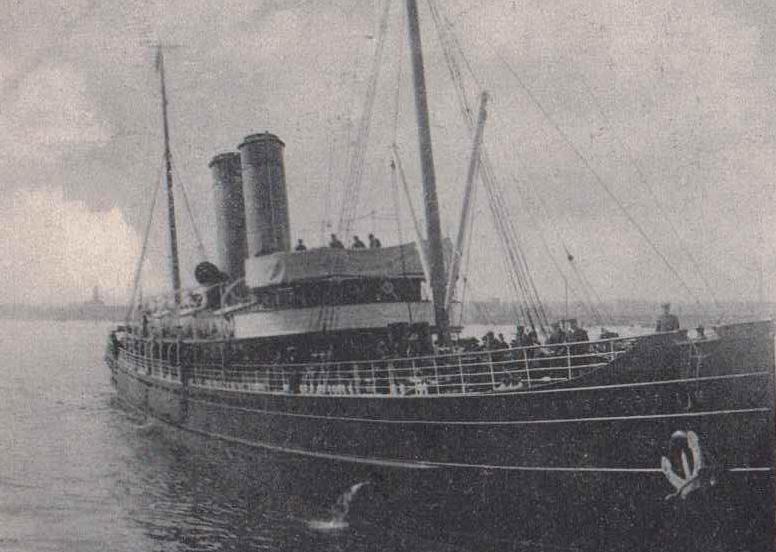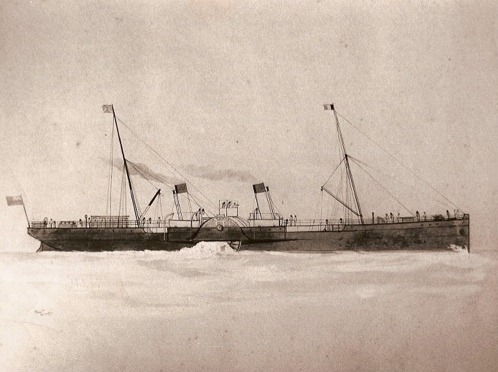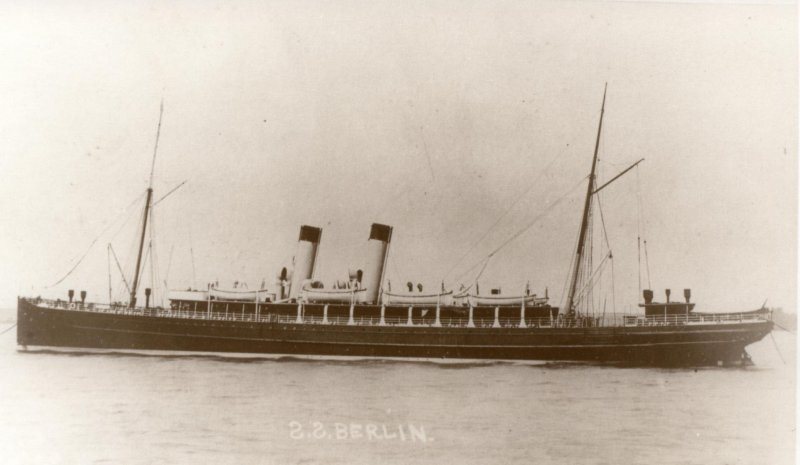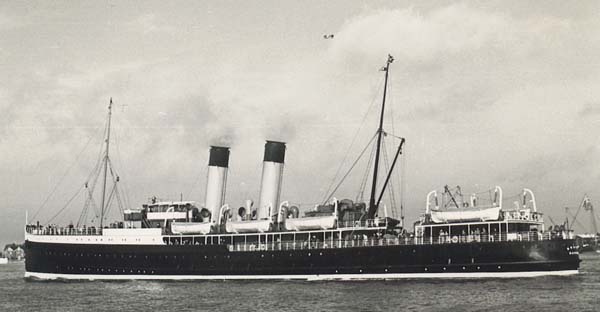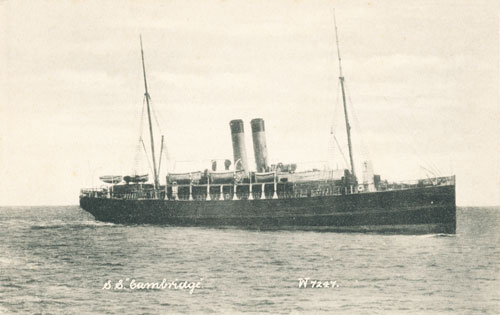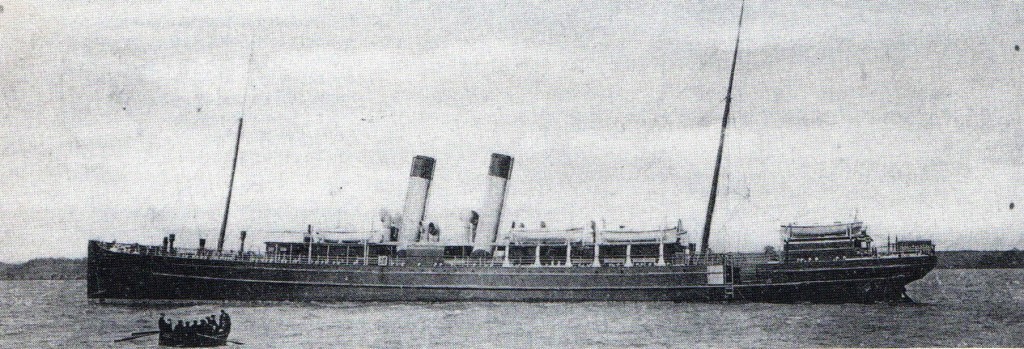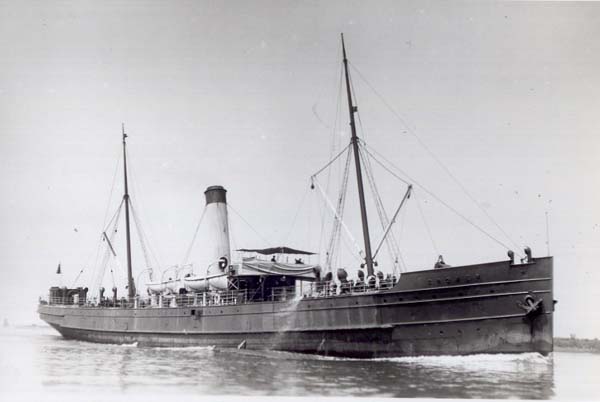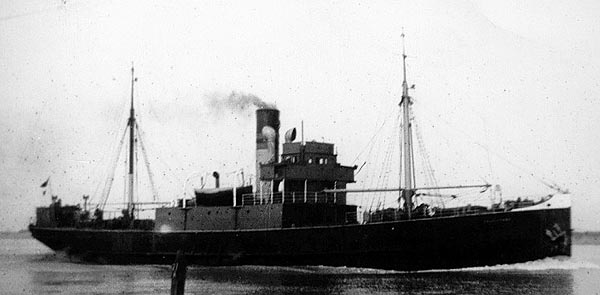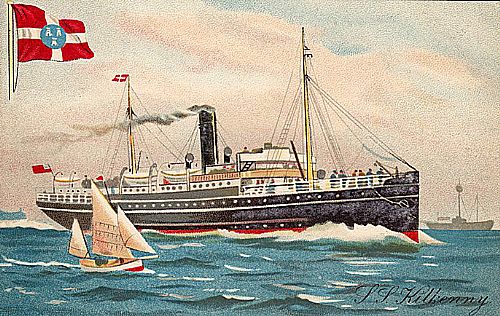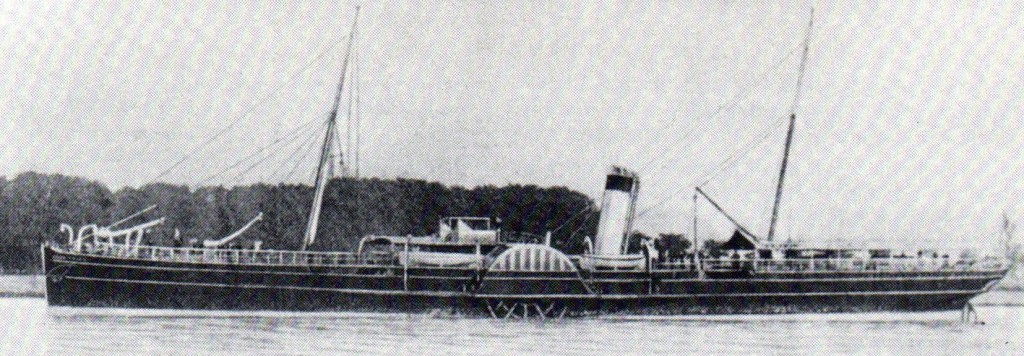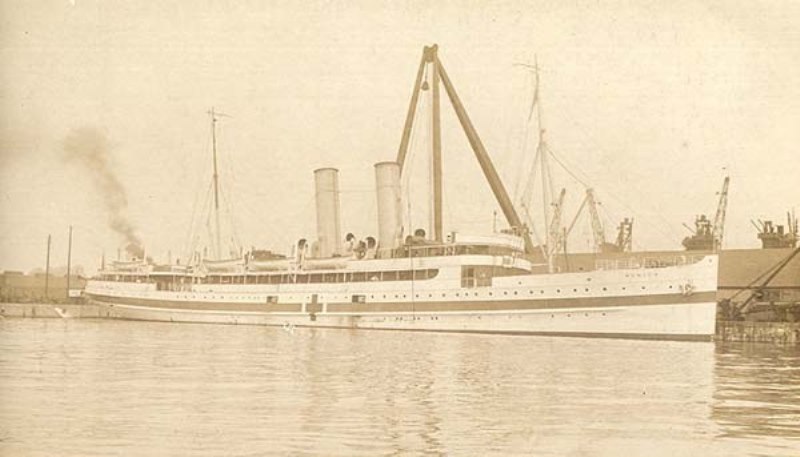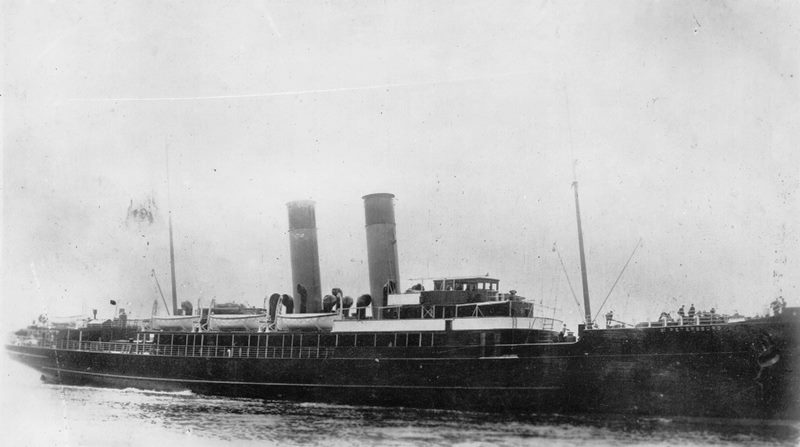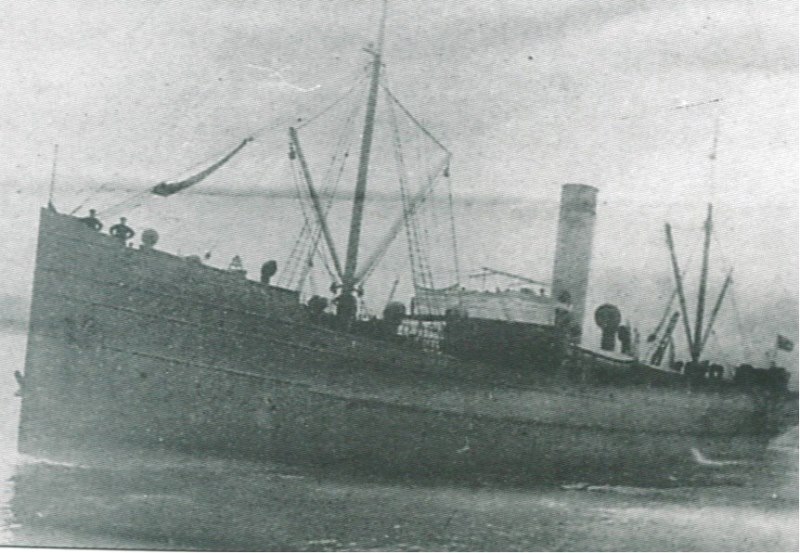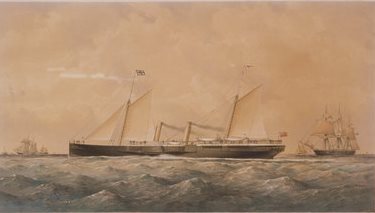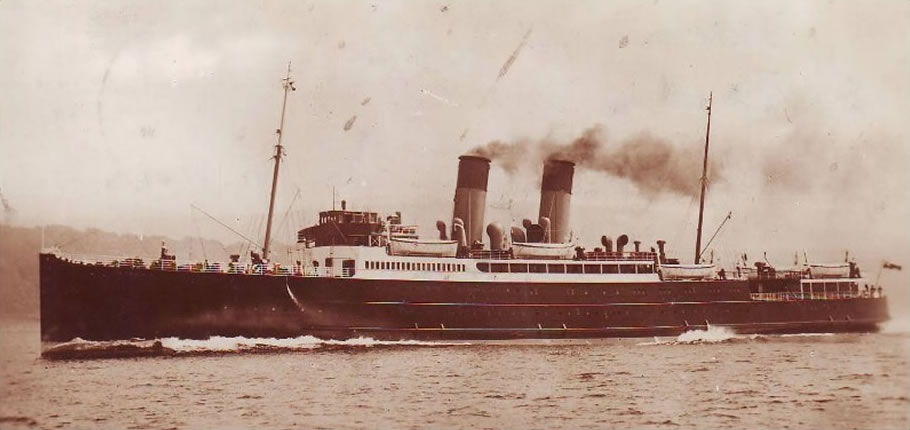
Great Eastern Railway
The Great Eastern Railway (GER) acquired Parliamentary powers to operate steamers from Harwich in 1863, some nine years after its line had reached the port. In fact, it had become a ship-owner in the previous year through its acquisition of the Eastern Counties Railway Company, which operated ferries on the Orwell and Stour in succession to the Ipswich Steam Navigation Company.
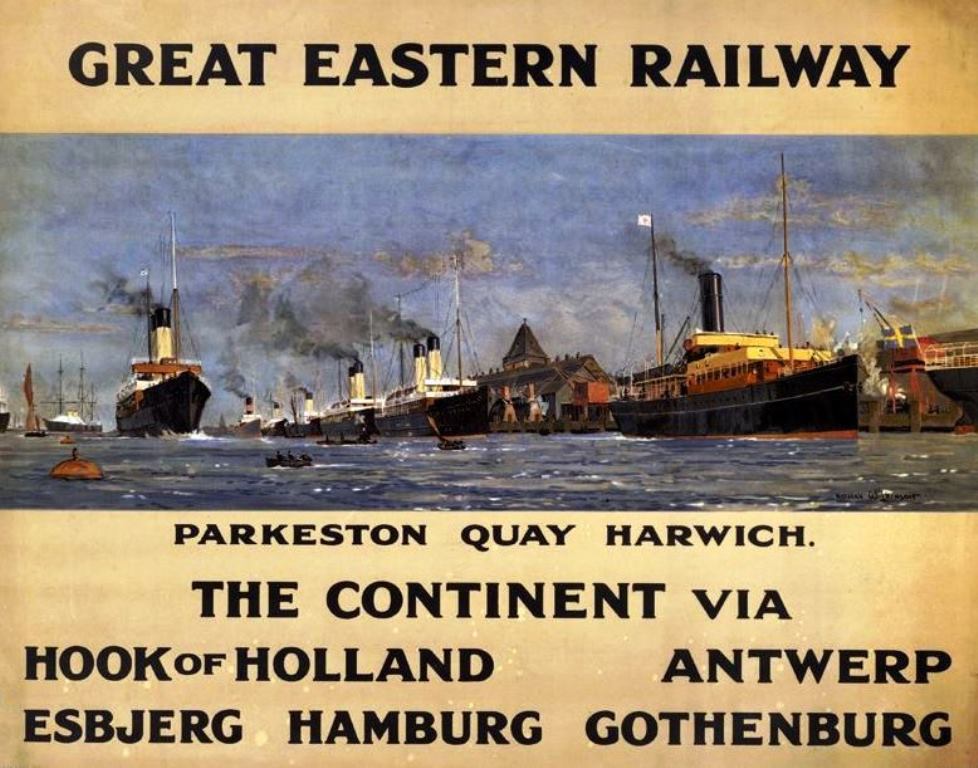
Great Eastern Railway
The GER built a new Continental Pier at the end of the railway tracks, and used their own ships from 1865, sailing to Rotterdam and Antwerp. Unfortunately the GER regularly found itself in dispute with Harwich Corporation, due to the limited quay space, and so between 1879 and 1883 a vast reclamation project was undertaken a mile and a half further west, outside the jurisdiction of the local council. This was opened as Parkeston Quay.
Adelaide
- Built. 1880 (IMO 1081173)
- Yard. Barrow Shipbuilding
- Class of Ship. Paddle Steamer
- Operator. Great Eastern Railway
- Route. Harwich-Rotterdam 1880-1896
- Length. 254ft. Gross Tonnage. 969
- Speed. 14.5 knots
- Status. Scrapped 1897
This vessel had the distinction of being the first G.E.R. Ship to be built of steel and the last one built for the international service to be propelled by paddles. Accommodation was for 113 first class and 58 second class berths. Her career with the company was not a long one, she was sold in 1896 to T.W.Ward, and the following year broken up in June.
Amsterdam (I)
- Built. 1894 (IMO 1099455)
- Yard. Earle’s Co, Hull
- Class of Ship. Passenger
- Operator. Great Eastern Railway
- Route. Harwich – Hook of Holland / Antwerp 1894-1939
- Length. 302 ft.
- Gross Tonnage. 1745
- Passengers. 338
- Speed. 18 Knots
- Status. Scrapped 1928
- T.S.S Amsterdam was built by Earle’s Shipbuilding of Hull for Harwich – Hook of Holland route, and later transferred to Antwerp service in 1910 when replaced by modern tonnage. Passenger accommodation was spaced over three decks. An entrance hall, luxury cabins, the ladies cabin and the dining room were situated on the main deck, while extra cabins were fitted one deck below. The First Class accommodated some 218 passengers while the Second Class situated at the stern and the after tween deck accommodated an extra 120 persons. Bunker capacity was for about 150 tons of coal and the ships consumed about four tons of coal each hour.
- On Thursday 31st August 1939 the Amsterdam sailed from the Hook of Holland for the final time.
Antwerp
- Built. 1920 (1131907)
- Yard. John Brown, Clydebank
- Class of Ship. Passenger
- Operator. Great Eastern Railway
- Route. Harwich-Antwerp 1920-1951
- Length. 337 ft.
- Passengers. 363
- Freight Capacity. 500 tons
- Status. Scrapped 1951
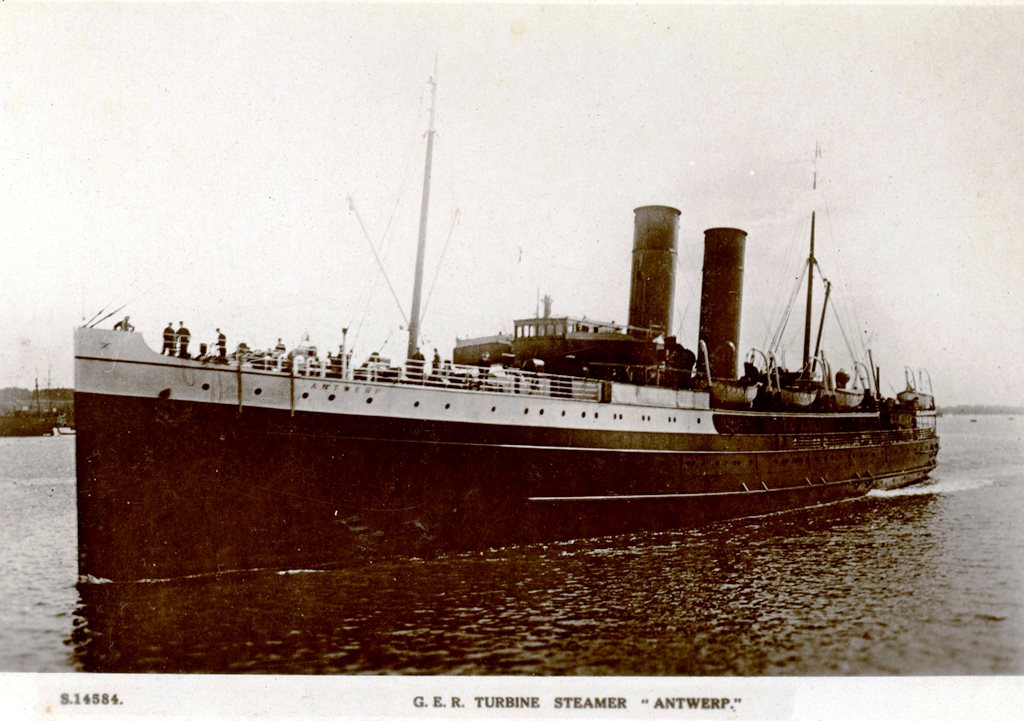
Antwerp
RMS Antwerp was built in 1920 for the Great Eastern Railway. Commissioned into the Royal Navy as H.M.S. Antwerp in November 1940, in October 1941 she sailed to the Mediterranean via the Cape, being based at Alexandria as a convoy escort and as a troopship. In March 1943 she was converted to a fighter direction and forward operations ship, and in this role carried Admiral Sir Bertram Ramsay and Admiral Lord Louis Mountbatten to the landings in Sicily in July 1943. During the rest of the war she served variously as an air-sea rescue ship, convoy escort, troopship and fighter direction ship.
Arriving back at Plymouth in March 1945, she was returned to LNER ownership but did not resume commercial service. She was refitted as a troopship and entered service from Harwich to Hook of Holland in this role in September 1945. This lasted until she was sold for breaking at Milford Haven, arriving there on 4 May 1951.
Avalon (I)
- Built. 1865 (IMO 1050004)
- Yard. Dudgeon
- Class of Ship. Passenger
- Operator. Great Eastern Railway
- Route. Harwich – Rotterdam 1864-1866
- Length. 239 ft.
- Gross Tonnage. 670
- Passengers. 150
- Freight Capacity.
- Speed. 12 Knots
- Status. Wrecked 1909
The first Avalon was the pride of the Great Eastern Railway. A schooner rigged paddle steamer of 541 tons she was built in London in 1865 by J & W Dudgeon at Cubitt Town on the River Thames and registered at Harwich in 1867. Carrying 400 passengers she operated between Harwich and Rotterdam until well into the 1880s, and traffic increased as the young bloods of the day travelled the Continent and the world for the benefit of their health and education.
On a Wednesday morning in November 1879 a curious incident occurred aboard the Avalon. The passengers had disembarked at Harwich Pier in the early hours of the morning and had proceeded by train to London.
Aboard the ship stewards were clearing up and preparing for the next influx of passengers and found on board was a small handbag belonging to one of the departed travellers. An officer opened the bag and found inside a peculiarly made “knuckle duster”. Watched by some of his companions he was in the act of fitting it in his hand when unwittingly his fingers touched a hidden spring and to everyone’s consternation the weapon fired a shot which whistled along the saloon and embedded itself into the woodwork, fortunately without doing harm to anyone. With due caution it was taken on deck and tried again, and found to contain no less than six shots.
It is recorded that during the day the owner of the “revolver/knuckle duster” missed his property and telegraphed for it, and it was accordingly forwarded to him.
Avalon was sold in 1888 to Earle’s Shipbuilding, Hull and wrecked off Jamaica in 1909.
Berlin
- Built. 1894 (IMO 1099454)
- Yard. Earle’s
- Class of Ship. Passenger
- Operator. Great Eastern Railway
- Route. Harwich- Hook of Holland 1894-1907
- Length. 302 ft.
- Gross Tonnage. 1745
- Passengers. 338
- Speed. 18 Knots
- Status. Sunk 1907
T.S.S Berlin was built for the Harwich – Hook of Holland service by Earle’s Shipbuilding of Hull. Berlin was a steel ship of 1,745 Grt; 302 feet 5 inches long, with a beam of 36 feet; twin screw, powered by two triple expansion steam engines producing 5,800 Ihp, giving her a speed of 15 knots. She had berths for 218 first and 120 second class passengers. Berlin was only carrying 90 passengers and 53 crew when she left Harwich at 22:00 on 20 February 1907, under the command of Captain John Precious. At 0600 the following morning Berlin broke in two amidships, abaft of the engine room. The fore part of the ship slid down the inner side of the breakwater, drifting for some 80 yards, before sinking with all those within.
Bruges
- Built. 1920 (IMO 1131908)
- Yard. Earle’s
- Class of Ship. Passenger
- Operator. Great Eastern Railway
- Route. Harwich- Antwerp 1920-1940
- Length. 321 ft.
- Passengers. 363
- Speed. 21 Knots
- Status. Sunk 1940
T.S.S Bruges was built by John Brown and Company at Clydebank for the Harwich – Antwerp service. 1940, Allocated to move British troops from Le Havre to Cherbourg in June 1940, as the German army advanced from the east. While anchored off Le Havre on the morning of June 11, she received a direct hit from an aircraft bomb and was beached as a total loss. Vienna was sent to look for her. Close to the Outer Gabbard light they discovered some wreckage and lifebelts together with a single body. 21 crew and 1 passenger lost. Caxton Hall Inquiry provide that the ship went down due to heavy loads on deck.
Brussels
- Built. 1902 (IMO 1109884)
- Yard. Gourlay Brothers, Dundee
- Class of Ship. Passenger Ferry
- Operator. Great Eastern Railway
- Route. Harwich – Antwerp 1902-1916
- Length. 285 Ft
- Gross Tonnage. 1380
- Passengers. 164
- Speed. 16.5 Knots
- Status. Scrapped 1929
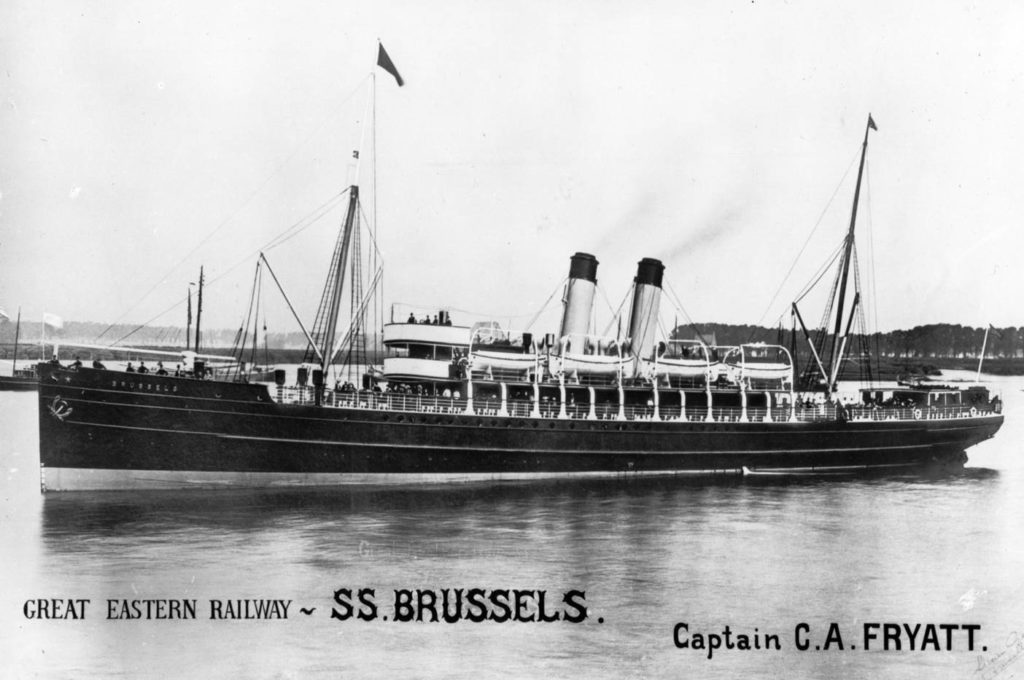
Brussels
In 1915 S.S Brussels tried to ram the German Submarine U-33. The ship was captured by Germany in 1916 and her captain, Charles Fryatt was executed after the Germans discovered his deed. Brussels was renamed Brugge and used as a depot ship at Zeebrugge. In October 1918, Brugge was scuttled by the Germans when they evacuated the port. The ship was raised by the Belgian Government and presented to the Admiralty in 1920. She was repaired and later renamed Lady Brussels. She was employed as an Irish Sea ferry, serving until scrapped in 1929.
Cambridge
- Built. 1886 (IMO 1091328)
- Yard. Earle’s Shipbuilding
- Class of Ship. Turbine Steam
- Operator. Great Eastern Railway
- Route. Harwich – Rotterdam/Antwerp 1886-1912
- Length. 280 ft.
- Gross Tonnage. 1160
- Passengers. 730
- Speed. 14.5 Knots
- Status. Scrapped 1937
T.S.S Cambridge was launched on the 11th October 1886, built by Earle’s Shipbuilding of Hull for service from Harwich and her career included Antwerp, Rotterdam and Hook of Holland routes. Sold in 1912 to Anglo-Ottoman Steamship Company.
In 1919 she was again sold to Administration de Navire a Vapeur Ottomane, Galatea, Constantinople, Turkey and renamed Gul Nehad, who then sold her in 1922 and was, renamed Gulnihal.
Chelmsford
- Built. 1893 (IMO 1099452)
- Yard. Earle’s Shipbuilding Co, Hull
- Class of Ship. Passenger
- Operator. Great Eastern Railway
- Route. Harwich – Hook of Holland/Rotterdam 1893-1910
- Length. 300.5 ft. Gross Tonnage. 1,635
- Speed. 17.5 knots
- Status. Scrapped 1934
S.S Chelmsford was launched on the 21st February 1893 by the Mayoress of Chelmsford On board there was a dining and a ladies saloon, smoke and stateroom and cabins for 200 passengers. On the 1st of June 1893 the opening ceremony took place at the Hook of Holland. The Chelmsford duly arrived thirty minutes early at 05.30 and disembarked her passengers before continuing to Rotterdam to unload her cargo. Had the distinction of being the vessel to open their Harwich-Hook service, was disposed of sale and was renamed Bretonne in June 1910, she was sold once more to the Embiricos family who renamed her Esperia, the Embiricos fortunes declined in 1933 and she was sold for scrap the following year after a career of over 40 years.
Clacton
- Built 1905
- Yard. Earle’s Shipbuilding
- Class of Ship. Cargo
- Operator. Great Eastern Railway
- Route. Harwich – Hook of Holland 1905-1914
- Length. 245 ft.
- Gross Tonnage. 820
- Passengers. None
- Speed. 14 Knots
- Status. Lost 22/10/1917
-
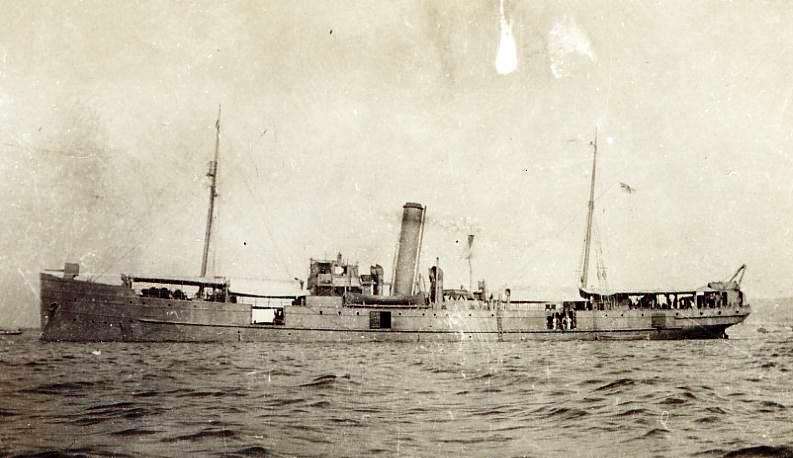
Clacton
T.S.S Clacton was used as a cargo vessel and was commissioned as H.M.S. Clacton on the 7th October 1914. Clacton was sunk by German submarine U73 on the 22nd October 1917 in the Mediterranean.
Claud Hamilton
- Built. 1875 (IMO 1074431)
- Yard. J. Elder & Co
- Class of Ship. Passenger
- Operator. Great Eastern Railway
- Route. Harwich – Rotterdam/Hook of Holland
- Length. 251 ft.
- Gross Tonnage. 962
- Passengers. 558
- Speed. 13 Knots
- Status. Scrapped 26/08/1914
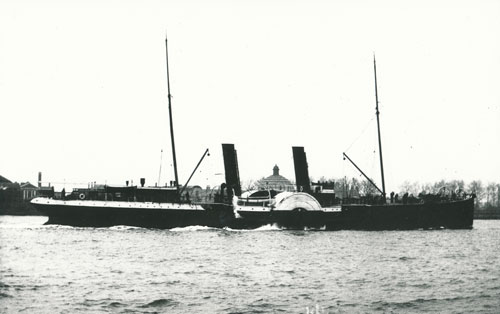
Claud Hamilton
John elder launched this ship on the 3rd June 1875 she was the largest steamer in the company and was named after the Chairman of the company and served the company for 22 years. In 1897 she was sold to the Corporation of the City of London and used between Gravesend and Deptford on the Thames as a cattle carrier before being purchased by Dutch Shipbreakers in July 1914.
Colchester (I)
- Built. 1889 (IMO 1091332)
- Yard. Earle’s Shipbuilding
- Class of Ship. Passenger
- Operator. Great Eastern Railway
- Route. Harwich – Antwerp 1889-1916
- Length. 280 ft.
- Passengers. 730
- Speed. 14.5 Knots
- Status. Scrapped 1919
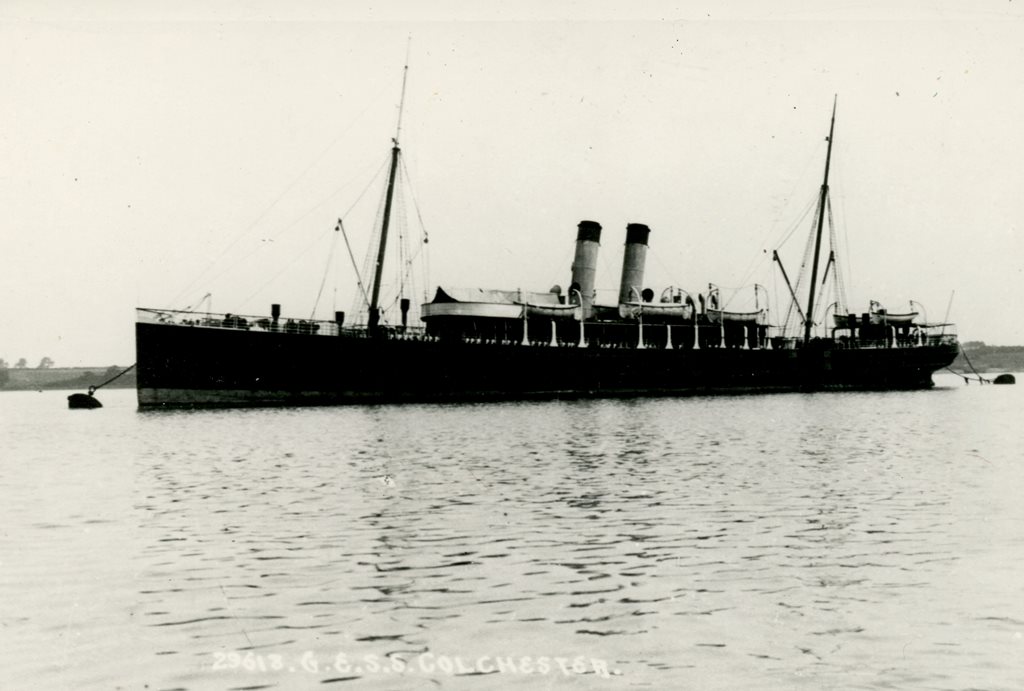
Colchester
T.S.S Colchester was built by Earle’s Shipbuilding of Hull and commissioned in 1889; she had a long career as a merchant vessel, until she was captured by the Germans during the First World War and subsequently sunk by the royal navy and scrapped in 1919.
Copenhagen
- Built. 1907 (IMO 1123935)
- Yard. John Brown, Clydebank
- Class of Ship. Passenger
- Operator. Great Eastern Railway
- Route. Harwich – Hook of Holland 1907-1914
- Length. 343 ft.
- Gross Tonnage. 2410
- Passengers. 520
- Freight Capacity.
- Speed. 20 Knots
- Status. Sunk 05/03/1917
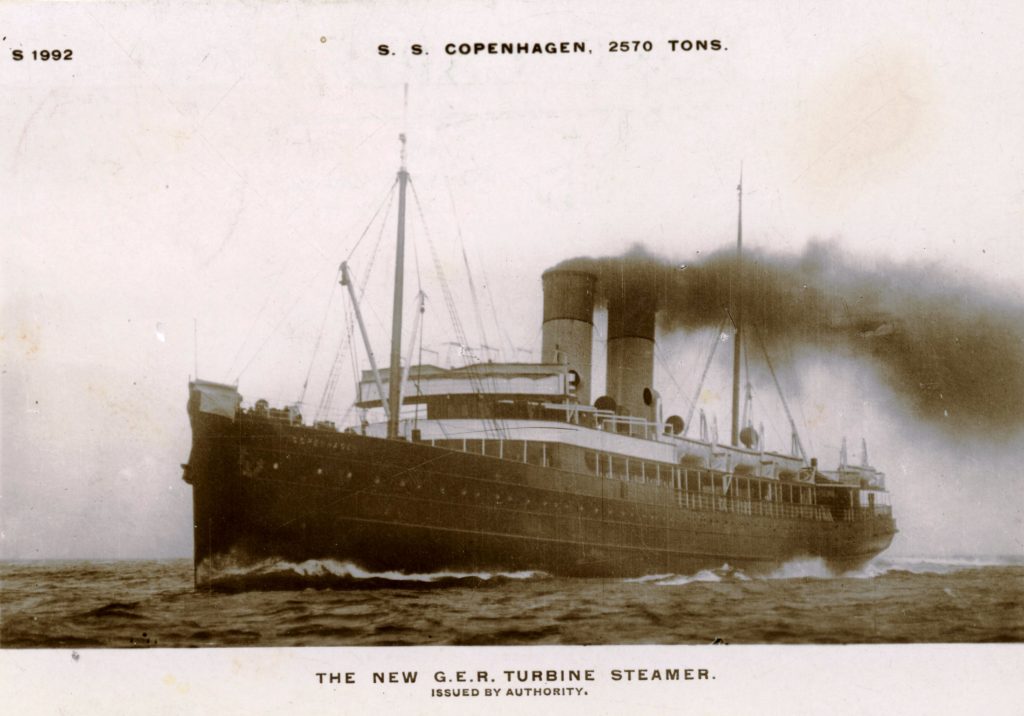
Copenhagen
T.S.S. Copenhagen was built by John Brown and Company at Clydebank as a replacement for the lost “Berlin” and was so successful that she was quickly followed by her sisters “Munich” and “St. Petersburg on the Harwich – Hook of Holland service. The vessel was torpedoed and sunk in the North Sea on the 21st March 1917 en route to Hook of Holland.
Cromer
- Built. 1902 (IMO 1109883)
- Yard. Gourlay Bros. & Co., Dundee.
- Class of Ship. Cargo Steamer
- Operator. Great Eastern Railway
- Route. 1902-1934
- Length. 74,80m
- Gross Tonnage. 812
- Passengers. None
- Freight Capacity. 450 tons + 86 cattle
- Speed. 13.5 Knots
- Status. Scrapped 1934
T.S.S Cromer was launched on the 22nd February 1902 by Miss A. Howard and was utilized as a cargo ship, After 32 years’ service she was scrapped in 1934.
Dresden
- Built. 1896 (IMO 1105423)
- Yard. Earle’s Shipbuilding
- Class of Ship. Twin screw steamer
- Operator. Great Eastern Railway
- Route. Harwich-Hook of Holland 1897-1915
- Length. 302 ft.
- Gross Tonnage. 1,805
- Passengers. 780
- Speed. 18 knots
- Status. Sunk 20/01/1918
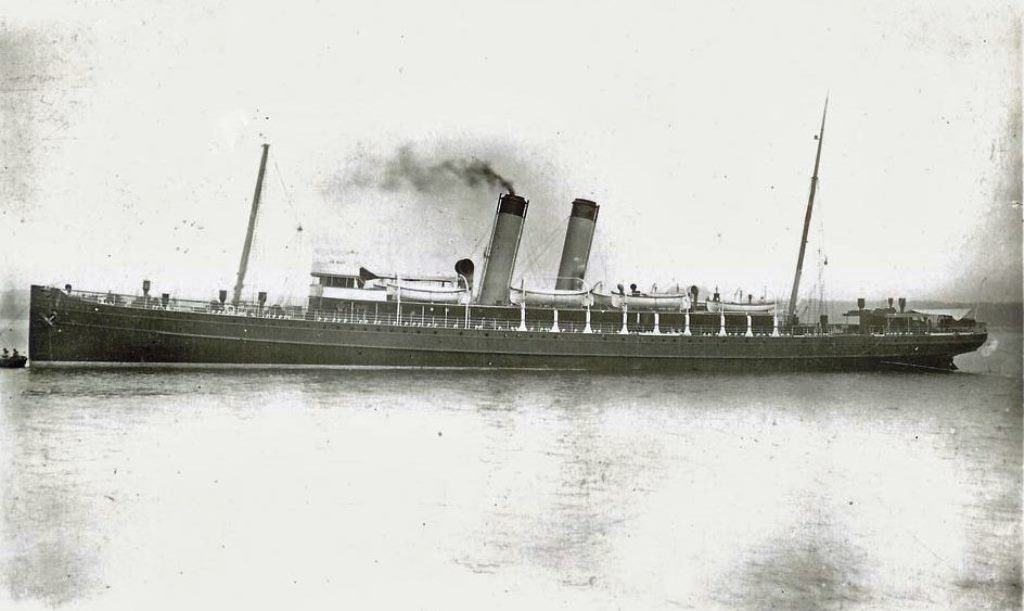
Dresden
T.S.S Dresden was launched on the 17th November 1896 and boasted a higher bridge than the previous ships. She has gone down in history as the ship which the world-famous German marine engineer Dr. Rudolph Diesel was travelling in October 1913 when he mysteriously disappeared and was assumed lost overboard.
At the start of World War 1 the ship was requisitioned by the Admiralty and renamed HMS Louvain. She was sunk in the Mediterranean on 20 January 1918 by the German submarine UC.22.
Felixstowe
- Built 1918 (IMO 1131905)
- Yard. Hawthorn & Co
- Class of Ship. Cargo
- Operator. Great Eastern Railway/LNER
- Route. Harwich –Antwerp 1919-1951
- Length. 215 ft.
- Gross Tonnage. 892
- Speed. 13 Knots
- Status. Scrapped 22/11/1957
S.S. Felixstowe was built in 1918 and served as a tramp steamer until 1942, she was requisitioned in London on August 3, 1941 for Admiralty service under the director of Wreck Dispersal. She was converted and fitted out as a wreck dispersal vessel at Deptford, re-measured and increased from 892 to 1,280 gross tons and commissioned on December 10, 1941 under Admiralty Blue Ensign, with a mixture of L.N.E.R. and Royal Naval personnel. As there was already an H.M.S. “Felixstowe” permission was given to for the name of the ship to be changed to “Colchester”. She was sent to Sheerness for duty and in March 1943 was transferred to Harwich Base.
Felixstowe was sold on the 18th October 1950 to the Limerick Steamship Company and renamed “Kylemore”. She was broken up in Rotterdam in 1957.
Frinton
- Built. 1903 (IMO 1117513)
- Yard. Clyde Shipbuilding
- Class of Ship. Passenger
- Operator. GER/LNER
- Route. Harwich- Antwerp / Hook of Holland 1919-1929
- Length. 269 ft.
- Gross Tonnage. 1419
- Passengers. 154
- Speed. 14 Knots
- Status. Bombed 1941
Built as SS Kilkenny for the City of Dublin Steam Packet Company, Dublin. Purchased by the G.E.R. in 1917 and renamed Frinton in 1919. Sold in 1927 to Samos Steam Navigation Company, Harwich resold in 1928 for service in the Mediterranean, being lost by bombing at Megara in April 1941.
Great Yarmouth
- Built. 1866
- Yard. Jones Brothers
- Class of Ship. Passenger
- Operator. Great Eastern Railway
- Route. Harwich – Rotterdam 1866-1872
- Length. 200 Ft.
- Gross Tonnage. 731
- Passengers.
- Speed. 10 Knots
- Status Wrecked 1887
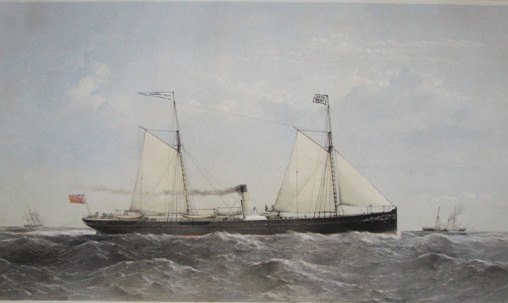
Great Yarmouth
Built 1866 by Jones Broths of London and employed carrying trade from London along the East Coast. Great Yarmouth was chartered by the G.E.R. for 3 months in 1876; In 1881 she was transferred to Gateshead and here was employed in the coal trade.
She was wrecked in 1887 in the Gulf of Bothnia.
Harwich
- Built 1864
- Yard. Dudgeon and Co
- Class of Ship. Paddle Steamer
- Operator. Great Eastern Railway
- Route. Harwich – Antwerp/Rotterdam 1864-1907
- Length. 65.58 m
- Gross Tonnage. 750
- Passengers. 110
- Speed. 10 Knots
- Status. Scrapped 1907
PS Harwich was built by Dudgeon and Company, London for the cattle trade between Harwich and Antwerp, she was converted into a passenger-cargo ship and was licenced to carry 110 passengers. In 1889 she was converted into a cattle carrier and served on the Harwich-Rotterdam route. Harwich was sold for scrap to Holland in October 1907.
Ipswich
- Built. 1883
- Yard. Earle’s Shipbuilding
- Class of Ship. Paddle Steamer
- Operator. Great Eastern Railway
- Route. Harwich – Antwerp 1883-1905
- Length. 260 ft.
- Gross Tonnage. 1,065
- Passengers. 126
- Speed. 14 knots
- Status. Scrapped 1909
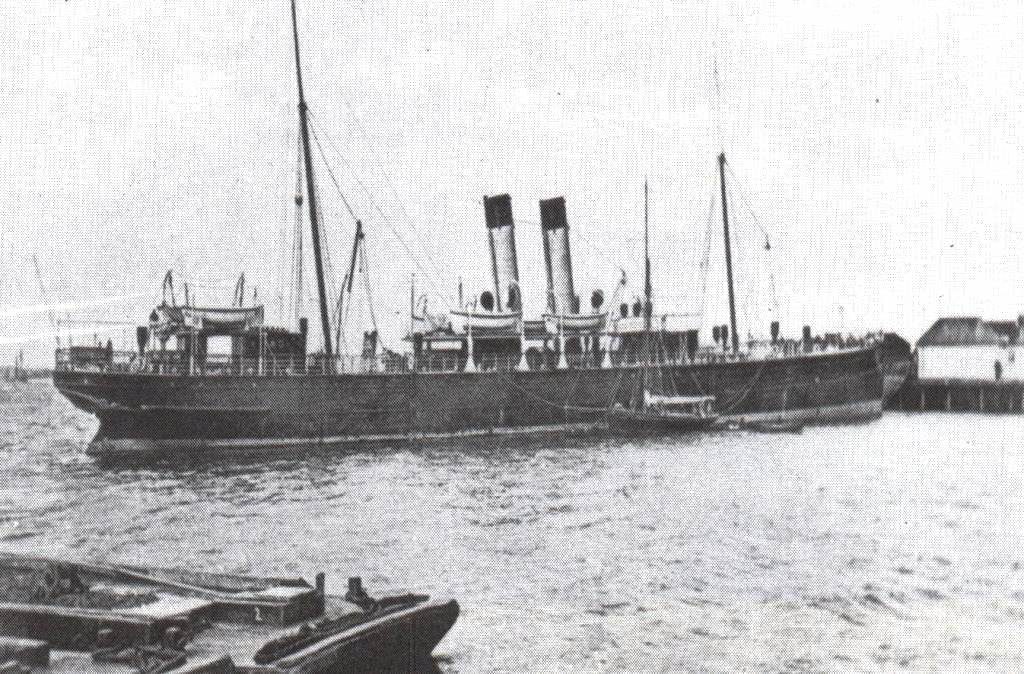
Ipswich
Built by Earle’s Shipbuilding of Hull, she was designed with her sister “Norwich” for the Company’s new quay at Parkeston; they had berths for 84 first class passengers and 42 second class. Operated on the Antwerp service until retired in 1905. Sold in 1906 to Shah Steam Navigation Co, Bombay, where she was broken up in May 1909.
Lady Tyler
- Built. 1880 (IMO 1081172)
- Yard. T&W Smith
- Class of Ship. Paddle Steamer
- Operator. Great Eastern Railway
- Route. Harwich – Rotterdam 1880-1893
- Length. 261 ft. Gross Tonnage. 995
- Passengers. 709
- Speed. 13 knots
- Status. Scrapped 1955
Ps Lady Tyler was launched at T & W, Smith’s shipyard, North Shields in 1880 after being christened by Lady Tyler. She was built to carry much weight whilst drawing little water, and although only built as a twelve and a half knot boat, she steamed regularly at 13 knots. After a short career of 13 years she was sold in 1893 to Earle’s of Hull and was eventually broken up in 1955 at Gravesend.
Malines
- Built. 1921 (IMO 1145402)
- Yard. W G Armstrong Whitworth .
- Class of Ship. Passenger
- Operator. GER/LNER
- Route. Harwich – Antwerp 1921-1940
- Length. 320 ft.
- Passengers. 1680
- Speed. 21 Knots
- Status. Scrapped 1948
-
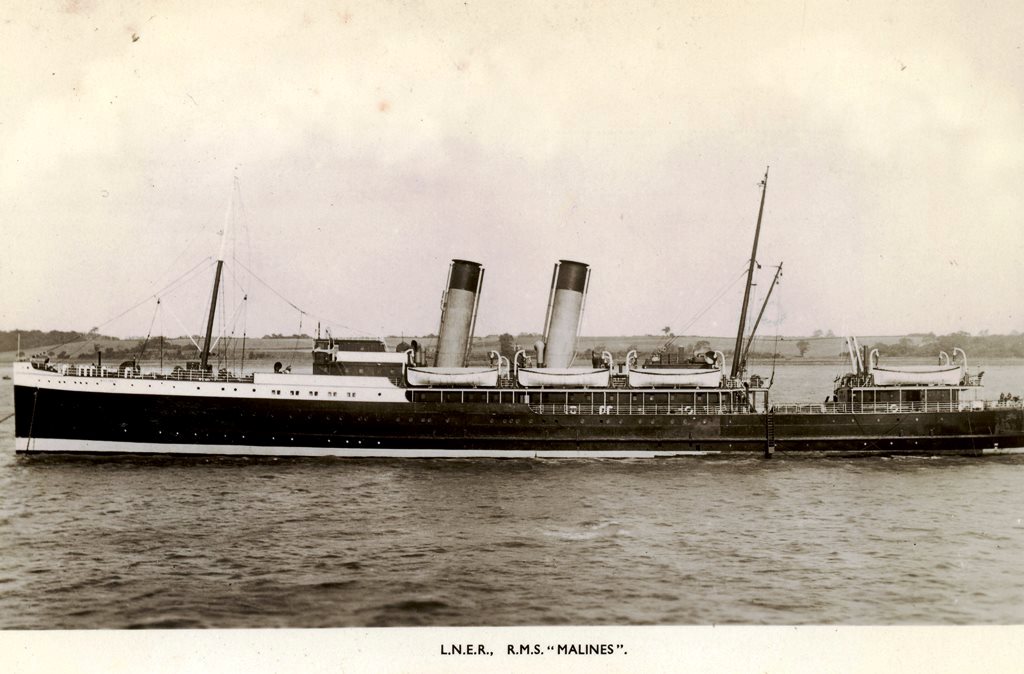
Malines
T.S.S Malines was built in 1921 for the Great Eastern Railway and passed to LNER in 1923 and served until laid up in 1945. She was torpedoed by an air attack and was beached off Port Said in July 1942. Having been raised in September 1943 and towed back to her builders, the machinery damage caused her to be laid up 1945 and finally scrapped in 1948.
Munich
- Built. 1908 (IMO 1123938)
- Yard. John Brown & Co. Ltd.
- Class of Ship. Triple screw steamer
- Operator. GER/LNER
- Route. Harwich – Hook of Holland 1908-1940
- Length. 331 ft.
- Gross Tonnage. 2410
- Passengers. 520
- Speed. 20 knots
- Status. Scrapped 1950
T.S.S. Munich was built by John Brown and Company of Clydebank for the Harwich – Hook of Holland service. A sister of “Copenhagen”. Requisitioned in 1918, renamed St Denis and converted to a hospital ship. She retained her new name on return to GER and passed to LNER in 1923. She was relegated to relief and secondary services in 1932. Was scuttled when cornered in Amsterdam in 1940. Having been raised by the Germans, she had her name changed to “Barbara” and was found in Kiel in 1945 where she served as an accommodation ship for Kiel University. In 1950 she was towed to Sunderland and scrapped.
Norwich
- Built. 1883 (IMO 1084034)
- Yard. Earle’s Shipbuilding
- Class of Ship. Paddle Steamer
- Operator. Great Eastern Railway
- Route. Harwich – Antwerp 1883-1911
- Gross Tonnage. 1,065
- Passengers. 126
- Speed. 14 knots
- Status. Sank 1920
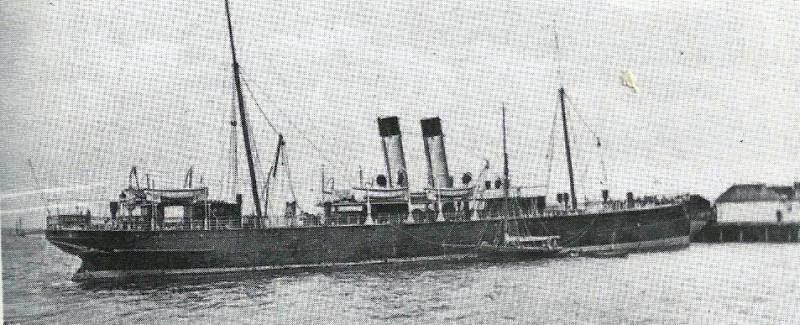
Norwich was built By Earle’s Shipbuilding at Hull as a sister to “Ipswich” for the Harwich – Antwerp service. Sold in 1905 to Channel Drydock & Shipbuilding Company, Harwich. Re-sold several times to companies in Cape Verde, Montevideo, New York and Mexico and sank in 1920.
Princess of Wales
- Built. 1878
- Yard. London & Glasgow Engineering Co
- Class of Ship. Paddle steamer
- Operator. Great Eastern Railway
- Route. Harwich – Rotterdam/Hook/Antwerp
- Length. 265 ft..
- Gross Tonnage. 1,098
- Passengers. 580
- Speed. 15 Knots
- Status. Scrapped 16/05/1895
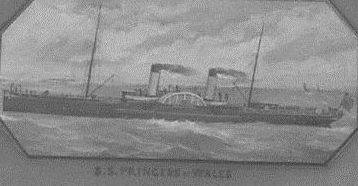
Princess of Wales
P.S. Princess of Wales was a two masted paddle steamer which operated between Harwich and Rotterdam and from Parkeston Quay to the Hook of Holland; her maiden voyage was on the 6th July 1878. After a career of 18 years she was sold for scrap on the 16th May 1895.
St. George (I)
- Built. 1906 (IMO 1123673)
- Yard. Cammell Laird & Co. Ltd
- Class of Ship. Passenger
- Operator. GER/LNER
- Route. Harwich- Hook of Holland 1919-1929
- Length. 352 ft.
- Passengers. 500
- Speed. 20 Knots
- Status. Scrapped 1929
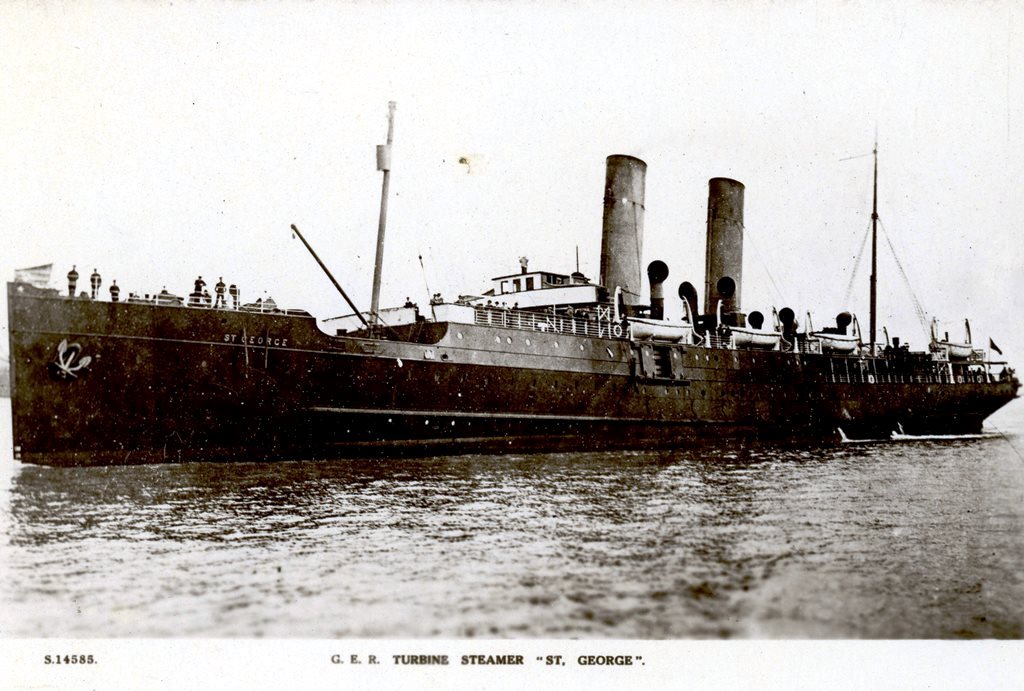
St George
A triple screw turbine vessel 2,500 GRT with a service speed of 20 knots, she was built by Cammell Laird and entered service for the Fishguard & Rosslare Railways and Harbour Co in 1906.
St George was sold in 1913 to the Canadian Pacific Railways for their coastal services. However, during the first world War ‘St George’ returned to British waters and, like her sister ships, became a hospital carrier. During that war the Great Eastern Railway not only lost from their Hook of Holland service their ‘Copenhagen’ (torpedoed), but failed to receive the new ship laid down in 1914 as ‘Stockholm’, which was completed by the Admiralty as an aircraft carrier, HMS ‘Pegasus’ in June 1919. Her reconversion to passenger service did not endear her to the Continental Booking staff: whereas her running mates ‘Archangel and ‘St Denis’ each had virtually identical passenger accommodation consisting largely of doubler and single cabins, ‘St George’ had a very high proportion of 4-berth cabins.
‘St George’ went to the breakers in 1929.
St Petersburg
- Built. 1910 (IMO 1123940)
- Yard. John Brown, Clydebank
- Class of Ship. Triple screw steamer
- Operator. Great Eastern Railway
- Route. Harwich – Hook of Holland 1910-1941
- Length. 331 ft.
- Gross Tonnage. 2448
- Passengers. 520
- Speed. 20 knots
- Status. Sunk 1941
ST Petersburg was built by John Brown and Company for the Harwich – Hook of Holland service. In 1916 she was renamed Archangel, she made her last scheduled sailing on the Harwich – Hook of Holland route on Easter Monday 21st April 1930. Archangel was bombed and sunk off East coast of Scotland in 1941.
Vienna (I)
- Built. 1894 (IMO 1099457)
- Yard. Earle’s Shipbuilding
- Class of Ship. Twin screw steamer
- Operator. GER/LNER
- Route. Harwich – Hook of Holland/Antwerp/Zeebrugge
- Length. 302 ft.
- Gross Tonnage. 1745
- Passengers. 338
- Speed. 18 knots
- Status. Scrapped 1930
T.S.S Vienna was built by Earle’s Shipbuilding at Hull and was launched as “Vienna”. Entered Harwich – Hook of Holland service with sister “Amsterdam” and was transferred to the Antwerp service in 1910. Renamed “Roulers” when she entered Harwich – Zeebrugge service in 1920. Passed to LNER in 1923.
Vienna was Broken up at Blyth in March 1930.
Yarmouth
- Built. 1903 (IMO 1116175)
- Yard. Gourlay Brothers, Dundee
- Class of Ship. Twin screw Cargo steamer
- Operator. GER
- Route. Harwich –Rotterdam 1903-1908
- Length. 74,80 m
- Gross Tonnage. 806
- Passengers. None
- Speed. 13.5 knots
- Status. Sunk 27/10/1908
T.S.S. Yarmouth was built by Gourlay Brothers, Dundee, for the Rotterdam–Harwich cargo service. The Yarmouth was the route’s mystery ship. On 27th of October 1908 she left the Hook of Holland under the command of Captain Avis at 10.30 with 430 tons of cargo and one passenger who could not have enjoyed the rather Spartan atmosphere experienced on board. Yarmouth sank with all hands in the North Sea on 27 October 1908.
30/10/1908 LOST CARGO BOAT
Seaman’s Body Identified. There is no fresh news at Parkeston Quay this morning regarding the loss of the Great Eastern Company’s cargo steamer Yarmouth, on the passage from the Hook of Holland to Harwich. The body which was landed at Sheerness last night has been identified as that of Bert Wright, aged 27, able seaman, of the vessel, whose parents reside at Wellington-road, Harwich. He is unmarried. His Majesty’s ship Attentive, which has been cruising in the vicinity where the Yarmouth is presumed to have foundered, is returning to Harwich this morning. Up to Thursday evening nothing had been heard of the remaining members of the Yarmouth’s crew. The body found by the Blake was picked up off the Gabbard Shoal and was landed at Sheerness on Thursday afternoon. On it were found three keys, a button- hook, and an insurance label. The man was about 6ft. in height and 35 years of age. On his underclothing were the initials “G. L. and another letter partly obliterated. He is believed to be one of the firemen. The Great Eastern Company’s steamer Vienna, which had been sent out in search of the Yarmouth, returned to Harwich on Thursday flying her flag at half-mast and bearing additional proofs that disaster had overtaken the missing vessel. She, however, brought back none of her crew, either alive or dead. The Vienna’s search had lasted 30 hours, and she had on board the bridge gratings of the Yarmouth, several of the hatches, and two lifebuoys. The crew stated that they saw hundreds of meat cases floating about, principally in the vicinity of the Gabbard. They twice spoke the lightship during their search, and were informed that the Yarmouth passed safely at five o’clock on Tuesday night. She was rolling heavily, with a heavy list to starboard. She however, seemed to be going fairly well, and way quite up to her standard time. The Vienna sent a boat to the lightship, and ascertained that the men on board saw no distress signals and heard no cries for assistance. On arriving at Hull on Thursday from Honfleur the master of the Fredheim, of Tons- burg, reported that when about two miles south-west of the Gabbard Lightship at ten p.m. on Tuesday he observed 20 to 30 bales of floating wreckage, apparently cotton. He heard a man crying in distress from the wreckage, but owing to the darkness and heavy sea he could not locate the man’s position. He stood by for two hours in the hope of effecting a rescue, and then proceeded m his voyage. The pantechnicon van found by the Blake floating in the North Sea was seen by representatives of the railway company and the firm charged with the removal of the furniture, and there is no doubt it formed part of the deck cargo of the Yarmouth. An Unavailing Search I the destroyers of Harwich flotilla are continuing their search in the vicinity of the spot where the Yarmouth was last seen, but it has so far proved unavailing the officials of the Great Eastern Rail way. However, still cling to the belief that some of the crew may have been rescued by a passing vessel which, if proceeding to a Baltic port. Might not be heard of for two or three” days.
Copyright Unknown.
Zealous
- Built. 1864 (IMO 1050020)
- Yard. Dudgeon & Co
- Class of Ship. Paddle Steamer
- Operator. GER
- Route. Harwich- Antwerp/Rotterdam 1864-1887
- Length. 230
- Gross Tonnage. 613
- Passengers. 301
- Speed. 12 knots
- Status. Scrapped 1887
P.S Zealous was built in 1864 by Dudgeon and Co of London, and was licensed to carry 301 passengers. Originally built for passengers only but later converted into a passenger-cargo ship. She served on the Harwich – Rotterdam and Antwerp routes and was scrapped in 1887.
We are adding more information to this site on a regular basis, if you wish to submit any photos or provide any information, then please use the contact page at the bottom of the screen.
Copyright Ownership.
We attempted to get the consent of copyright holders to use this material for nearly all of the photographs on the website.
In the few cases where names are available, a thorough search was made using telephone directories, photographic copyright directories, People Search and Google Area Search. None of the copyright owners could be traced in this way and we believe we have exhausted all reasonable avenues.
The consensus opinion of these authorities was that if any two of the following situations applied we would be deemed to have taken sufficient action to avoid infringing copyright laws:
- Reasonable efforts made to contact the copyright holder
- No financial gain will be made in relation to the photos
- A letter is obtained from present owner of photos
- There is a proviso included stating that if offence is caused document will be removed
The website owner undertakes to remove any photograph from the website where offence is caused. All the above conditions have therefore been met.
← Höegh Ugland Fred Olsen Lines →